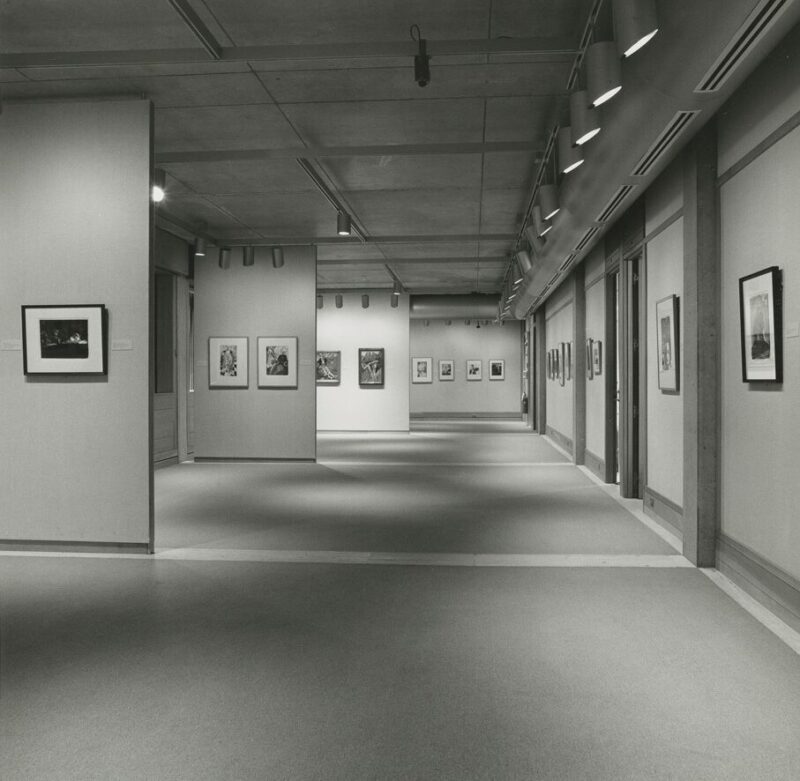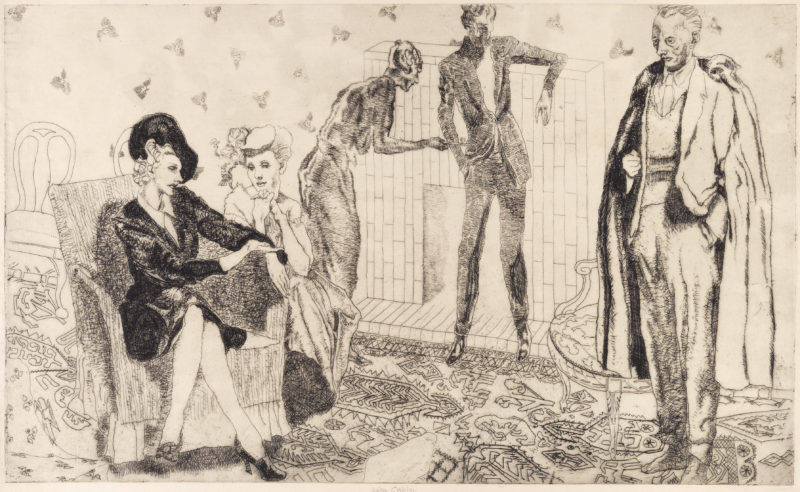
From 1906 until his death in 1950, John Copley dedicated himself to making prints. He was one of the most committed and prolific printmakers of the 20th century and made over 400 works: 253 lithographs and 155 etchings, besides paintings and drawings.
John Copley was born Herbert Crawford Williamson in 1875, the only child of William Williamson, Professor of Botany at Manchester University and his second wife Annie Copley Heaton. Copley was always his working name, but this was not formalised by Deed Poll until 1927.
He first took up etching when still at school, but his juvenile works have not survived. Mr Cornish, a Manchester bookseller, had shown him some etchings when he was eight or nine. In a letter of 1931, Copley wrote that he had loved prints ever since. He left school at fifteen and attended occasional classes at the university and the School of Art in Manchester before the family moved to London.
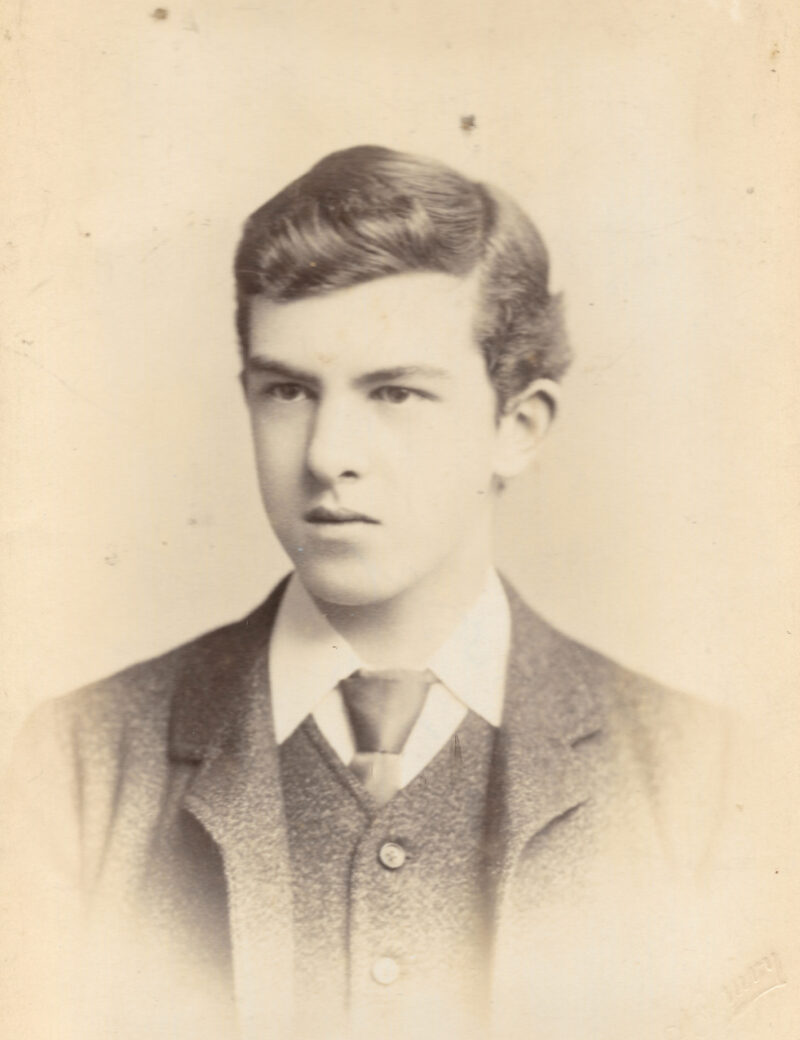
John Copley studied painting at the Royal Academy Schools from 1892 to 1897, and left for Italy the following year, where he learned to speak the language fluently. His time there was marred by recurrent illness, and he returned to England in 1900. Little is known about his life in the years from then until his first lithograph was published in 1909. A chronic heart condition repeatedly interrupted his attempts to start a career as an artist. However he became a founder member and first Secretary of the Senefelder Club, set up in 1908 to revive interest in lithography among artists. Through the club he met the artist Ethel Gabain and they married in 1913. He printed the editions of all his own works, as well as those of his wife who made nearly 400 prints herself. Although he painted in oils later in life, black and white was to be the principal vehicle for his art.
His lithographs were shown at the first Senefelder Club exhibition held at the Goupil Gallery in 1910. In 1914 the same gallery mounted a joint exhibition of lithographs by John Copley and Ethel Gabain. The following year Harold Wright, who ran the print department at P. & D. Colnaghi & Co, approached Ethel Gabain, suggesting that her work might be better represented by his firm, and in due course Colnaghi’s also took on John Copley. The association lasted over thirty years, and Harold Wright became the authority on both artists’ work. He compiled the first catalogues of their lithographs, covering the period up to 1923, which were published in The Lithographs of John Copley and Ethel Gabain, Albert Roullier Art Galleries, Chicago 1924. He maintained a manuscript list in continuation of this, and the full catalogue was published by The Fine Art Society in 2000.
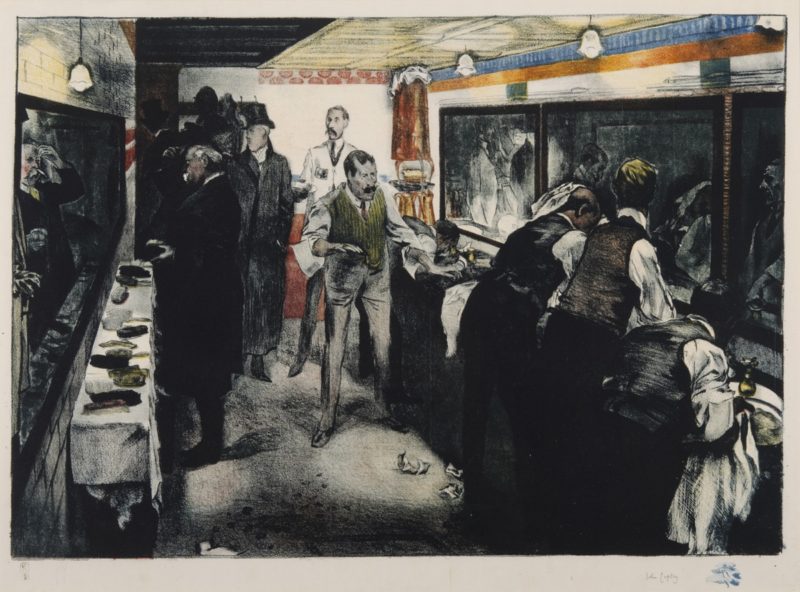
John Copley’s first lithographs were published in 1909 and included a set of 22 titled The Fall and Rise of His Imperial Majesty Jacques Démodé, Emperor of the Sahara. The most complex among the total of 31 lithographs he made in 1909 is A Lavatory, which was shown at the Senefelder Club exhibition, and of which the Victoria & Albert Museum bought an impression. Printed in seven colours, it shows a scene in a lavatory below the Empire, Leicester Square, London. Two further colour prints followed, A Tea Shop and A Daylight Lamp, but the response from buyers appears to have been disappointing and Copley reverted largely to black and white thereafter. In 1910 he produced the monumental Lacrosse, a work inspired by a match played by two teams visiting from Canada.
The Surgeon (1911) is printed in four colours and shows the operating theatre at the Military Hospital, Millbank, London. Athletes Dressing (1912) is the most elaborate of all the colour prints, a painterly image which dispenses with black entirely and uses thirteen colours.
In 1914 Copley made a series of‘Studies’ of his wife at home and then his final colour prints, inspired by a day at Epsom Races, In the Paddock and After the Finish. The following year he made Recruits, which shows a squad of marching men, still in civilian clothes. The artist himself, who was thirty-nine when war broke out, volunteered for active service but was turned down on medical grounds.
Although the subjects he chose between 1914 and 1918 did not for the most part reflect the war, in contrast to the pre-war works, many of them convey a sense of unease, such as Books (1915), Tennis Players and Five Girls (1918). Four are studies of Belgian refugees in England and The Ambulance (1918) is one of the largest lithographs.
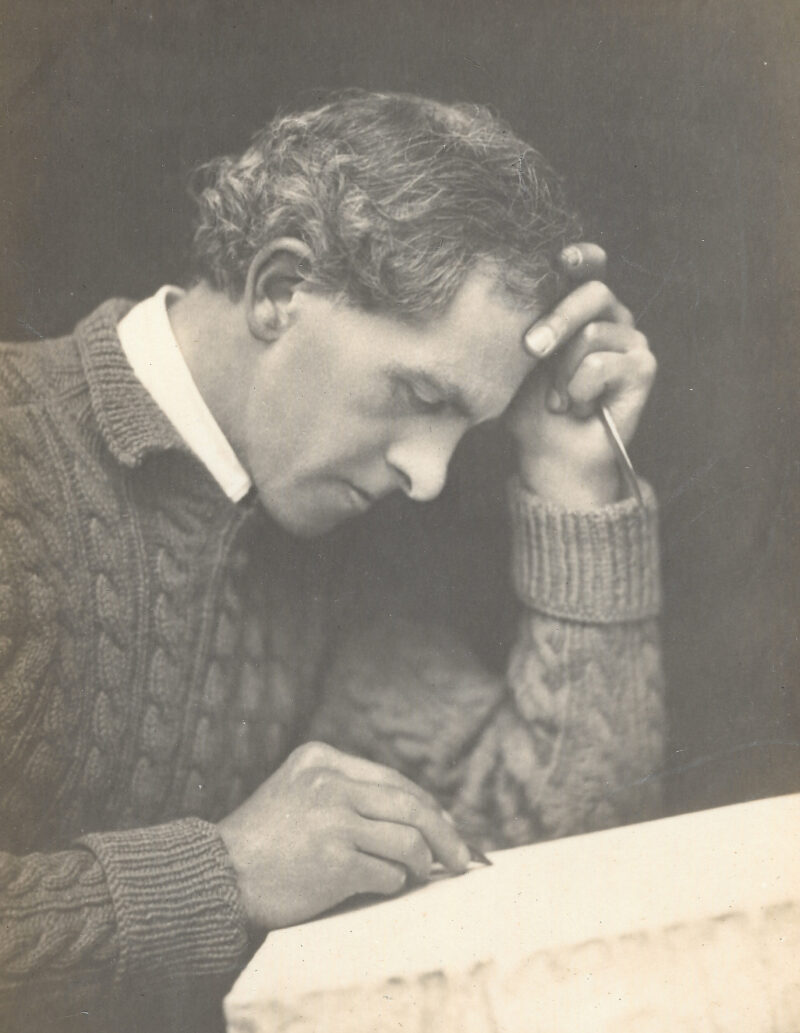
In 1917 he resigned from the Senefelder Club following a disagreement over whether to adopt a more commercial approach. He continued to make lithographs, the medium with which he is most closely associated, but also took up etching again. About this time they moved to 10 Hampstead Square, London.
In 1919 and 1920 John Copley suffered a recurrence of his heart trouble, was confined to his home and forbidden from even drawing for more than an hour a day. He made smaller works during this period including a series of‘Madonna’ subjects suggested by his reading of Dante’s‘Vita Nuova’. The condition continued to afflict him and between 1925 and 1927 the Copleys moved to Italy to try to restore his health.

Ethel Gabain found the family a small rented house overlooking the Mediterranean in Alassio, Villa della Pergola. John Copley spent his time in the garden, reading and working. Instead of stones, he drew on lithographic paper. They stayed there for two years and on his return to London, a series of etchings of Italian subjects were issued. More followed in 1932 and for the next six years he worked in both etching and lithography.
His final lithograph was made in 1938. The heavy lithographic press had become more than he could manage, so instead, he channelled his energies into etching. By this time the medium had been largely abandoned by other artists and by collectors which in a sense gave him a free hand to explore it. Etching had had its heyday in the 1920s when contemporary prints were immensely popular on both sides of the Atlantic and beyond. Prices for the work of certain etchers had risen spectacularly but both the market and interest collapsed in the wake of the Wall Street Crash in 1929. He worked in what had become a highly unfashionable medium.
From 1932 until his death in 1950, John Copley made over 100 etchings, many of which were not published and exist in a few impressions only. Several of 1932 depict subjects in Mallorca and in 1936–37 there a range of subjects including head studies, racehorses, landscape and figure studies. The landscapes are atmospheric, in rain, in mist, with moon and rainbow. After a hiatus, working on larger plates, 1939 saw two of his finest etchings, Quartet and An Autumn Afternoon on Hampstead Heath, also the subject of an oil painting. The models were Carmen Watson and an Italian named Gallo, who frequently sat for him.
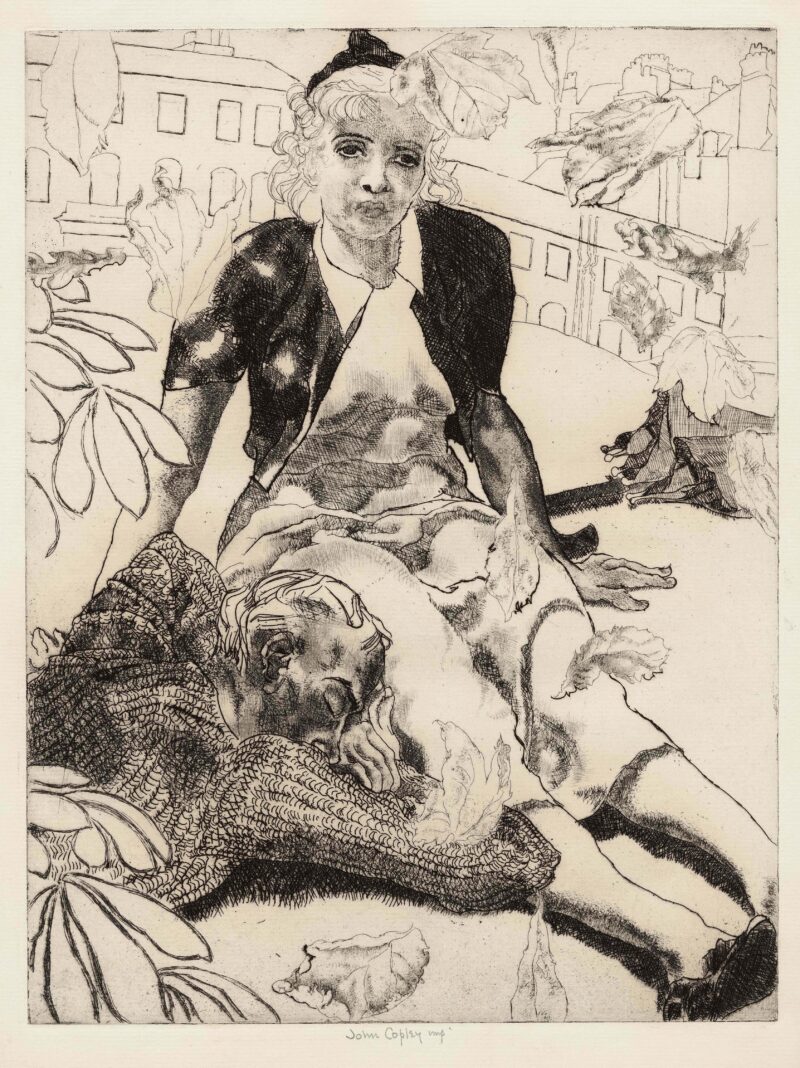
In 1940 he continued to make large etchings, another musical subject Trio, and two outstanding works Figures in the Wind and London Snow. The latter shows Jewish refugees near his home in Hampstead. Early in that year his younger son Christopher committed suicide, and this tragedy coincided with a rapid deterioration in his wife’s health. Undaunted, Ethel threw her remaining energies into her work as an Official War Artist, and John accompanied her on the long journeys. She went to lumber camps in Banffshire and in 1943 he made etchings based on landscapes he had seen in Scotland, Aviemore, Loch Morelich and the Cairngorms.
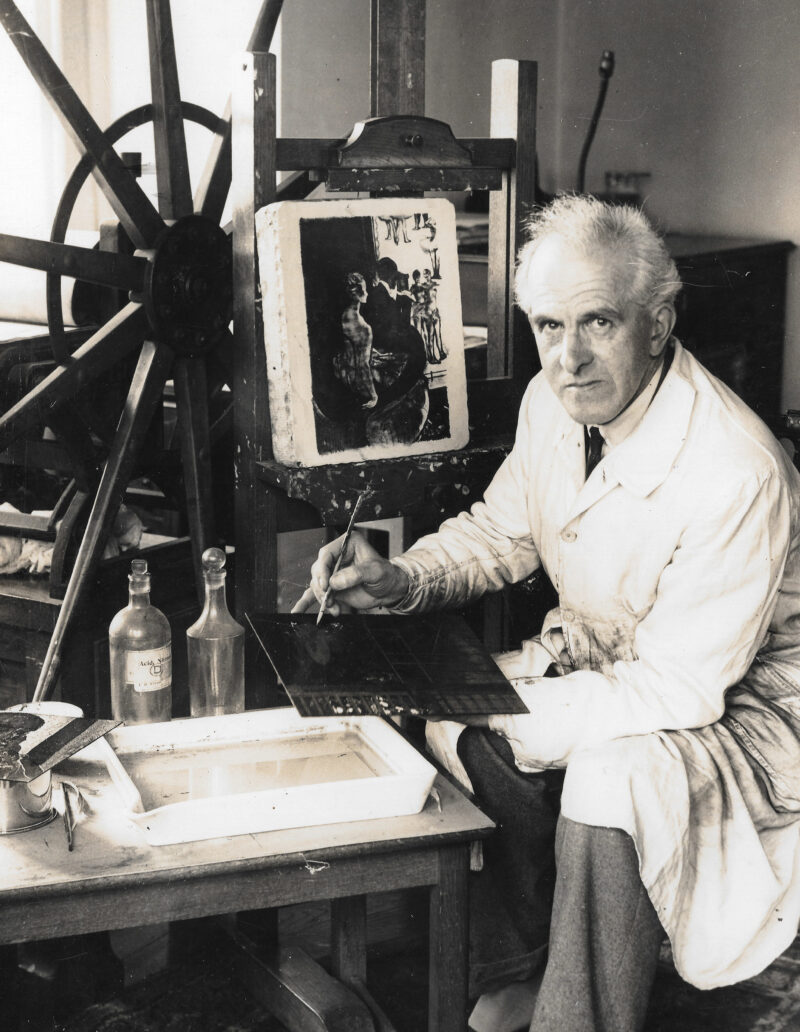
Figure in Tumult, A Figure in Anger and A Figure in Distress done in 1944 perhaps reflect his own state of mind. After the War he made 45 etchings, including some of his finest: French Songs (1946), People in a Room and Figures in Sunlight (1947), In the Tube and A Man pulling off his Coat (1948), this last based on a much earlier study of workmen. In 1949 he made two strikingly different self-portraits, The Pink Vase and In my Studio, and the monumental Through the Olives.
After watching a polo match at the Hurlingham Club, London in 1939, he made two etchings based on what he had seen. Some years later these were submitted for the 1948 London Olympics, in which Art Contests were a sport. It was most likely Harold Wright, head of the print department at Colnaghi, who had represented both him and his wife for nearly 40 years, who made the submission. John Copley was awarded the silver medal in Graphic Art and he thus became and remains the oldest-ever recipient of an Olympic medal.
In 1947 John Copley was elected President of the Royal Society of British Artists and this brought him into contact with younger artists whom he encouraged, such as Michael Ayrton, Patrick Heron, Paul Hogarth and Carel Weight. He staged exhibitions of works by foreign artists at the RBA, then in Suffolk Street, near the National Gallery. The most successful was of Giorgio de Chirico and on another occasion he invited Vivien Leigh to open the Society’s annual exhibition, resulting in such a crowd at the private view, that many never got into the gallery.

Ethel Gabain struggled with illness for over ten years, and curiously this period saw her previously invalid husband respond energetically, caring for her but socially active as he had never been before. He worked with vigour and expressed himself with freedom and originality, combining his natural oddity of vision with technical daring. When his wife died in 1950 he organised a memorial exhibition of her work at the RBA. Unwilling to live without her, he took his own life five months later.
The first one-man show of John Copley’s work was staged in America at the Yale Center for British Art, New Haven in 1990. The Center also has an important collection of his work. A complete list of his lithographs was published by The Fine Art Society in 2000, following the first catalogue of his etchings published by the gallery in 1998. The Fine Art Society staged four exhibitions of his work.
